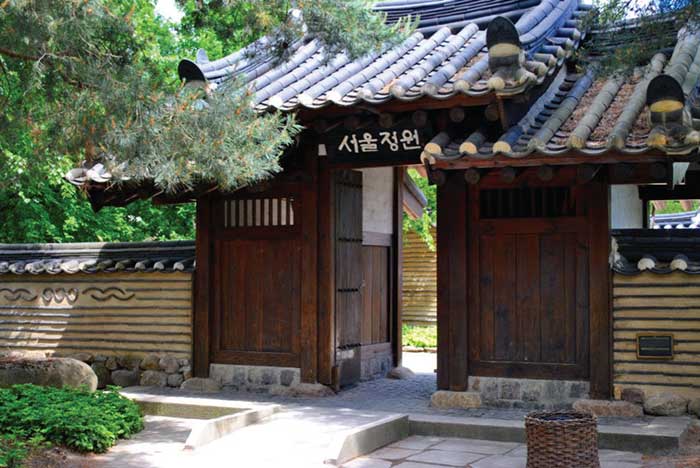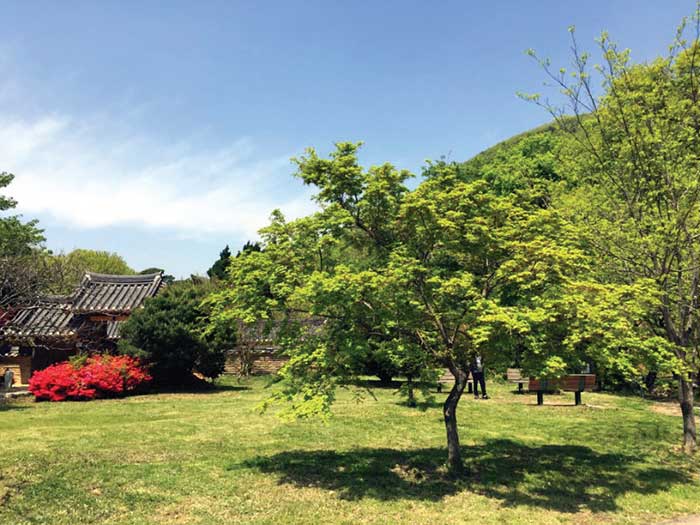내가 동아시아 미술사와 한국학 공부를 시작했던 2010년으로부터, 현재 독일에는 한국에 대한 인식과 대중성에 많은 변화가 있었다. 오랫동안 중국과 일본이 동아시아의 예술 전반을 압도하여 왔으나, 이제는 한류가 장악했다. 이러한 변화의 주요 원인 중 하나는 한국의 국외 문화 정책으로, 한국의 예술과 문화가 전세계로 활발히 전파되고 있다. 나는 이를 베를린의 서울정원(Seouler Garten)을 주제로 한 석사 논문에서 다룬바 있다. 서울시는 2006년 도시 간 협력의 하나로, 16세기 경주 독락당을 바탕으로 대표적인 한국의 정원을 구성하여 베를린에 설치하였다. 논문을 준비하며 감사하게도 이 정원에 대한 계획문서를 지원 받았기 때문에 그것을 바탕으로 귀한 통찰력을 얻어 논문을 완성할 수 있었다. 베를린에 있는 이 정원은 여느 한국 전통 별서정원과 다른 특징이 많다는 것이 인정되지만, 서울시는 그대로 소개하기로 결정하여 그 이유가 궁금하다. 2016년 독락당에 대한 연구를 위해 한국을 방문했을 때, 서울시청 또한 보러 갔다. 베를린 서울정원의 원래 특색이 아닌 많은 부분은 중국과 일본과 비교하였을 때 한국 문화의 특별함을 드러내고 강조하려는 의도이다. 훔볼트포럼 한국 전시실에 대해 제기된 염려에 대한 이해를 심화하는 데에도, 이 정원에 대한 계획 문서에 관한 연구가 도움이 되었다.
 베를린의 서울정원 입구 ⓒ 2016 Maria SOBOTKA
베를린의 서울정원 입구 ⓒ 2016 Maria SOBOTKA
 경주 독락당 입구 ⓒ 2016 Maria SOBOTKA
경주 독락당 입구 ⓒ 2016 Maria SOBOTKA
훔볼트포럼과 같은 기관에서도 한국에서 다시 제기되고 있는 우려에 대하여, 특별히 숙고할 부분이 있다. 앞으로 독일기관의 첫 번째 한국 담당 지정 큐레이터로서 베를린에서의 한국미술의 인지도를 높일 수 있게 된 것을 큰 기쁨과 영광이라고 생각하며 이에 대한 대한민국 문화체육관광부의 관대한 지원과 지지에 대하여 감사드린다.
베를린의 인류학박물관과 아시아미술박물관이 보유한 소장품은 큰 잠재력이 있다. 처음으로, 한 명의 학예사가 이를 통합적으로 관리하며 박물관에서 독일의 역사와 전통에 대해 질문하고 새로운 발표에 대한 가능성을 제안할 수 있게 되었다. 독일에서 소위 말하는 비유럽예술과 문화가 가지는 중요성과 의미는 무엇일까? 독일의 수집 역사에 대해 우리는 무엇을 알고 있나? 한 예술과 그 효과를 수용한다는 것은 독일의 수집과 전시접근 방식에 어떠한 영향을 미칠까? 2023년 올해에 있을 전시를 위하여 베를린에서 필자는 두 기관 소장품의 기원과 발전을 살펴보고 있다. 인류학박물관에 최초로 소장된 작품은 막스 폰 브란트나 폴 게오르크 폰 묄렌도르프와 같은 독일 외교관이 1900년 이전에 조선을 여행했던 시기의 초기 관계를 반영한다. 그 이후의 유물은 분단된 도시로서 베를린이 가진 격동의 역사를 증언한다. 김일성이 에리히 호네커에게 선물한 병풍도 소장되어 있으며, 독일의 프란츠 에케르트가 작곡한 한국의 국가 ‘애국가’의 악보집 등 몇 가지를 더 언급할 수 있을 것 같다.
아시아미술박물관이 보유한 한국 소장품 가운데 중요한 일부 유물은 더욱 더 깊은 연구가 필요하다. 기쁘게도 우리가 소장 중인 고려 시대 불화 <지장시왕도(地藏十王圖, Bodhisattva Jijang and the Ten Kings of Hell)> 에 대한 연구를 수행할 수 있게 되었다. 한국의 국외소재문화재재단 덕분에, 올해 고려시대 안료, 광물, 회화 기법의 활용에 대하여 더욱 깊이 파고들 수 있게 되었다. 앞으로 더 많은 연구와 프로젝트가 따르게 될 것이다.
Korean Art and Culture in Berlin
Since 2010, when I started my studies in East Asian Art History/Korean Studies, the perception and popularity of Korea have changed significantly. China and Japan dominated the arts of East Asia for a long time. Now Hallyu has taken over. South Korea’s foreign cultural policy is one of the main reasons for this change. Korean arts and culture are actively propagated. I set this out in my Master’s thesis on the Seouler Garten in Berlin. The city of Seoul gifted the Seouler Garten to Berlin as part of their city partnership agreement in 2006, the role model being the 16th-century private retreat Dokrakdang in Gyeongju. The garden in Berlin admittedly comes with many more features, whereby the majority is not part of Joseon-period literati gardens. The Seoul Metropolitan Government still decided to have these. I wondered why. When I visited Korea in 2016 to study the Dokrakdang, I also went to see the Seoul City Hall. They generously supported me with the planning documents on the garden in Berlin, from which I gained rare insights. Many of the Seouler Garten’s non-original features intend to introduce and highlight the uniqueness of Korean culture, especially in comparison to China and Japan. Studying the planning documents helped me in gaining a deeper understanding of the concerns raised in the debate on the Korean gallery at Humboldt Forum too.
The confrontation with the concerns about South Korea’s (re)presentation, particularly in a place such as the Humboldt Forum seems necessary. Thanks to the implicit commitment of support and the generosity of the Ministry of Culture, Tourism, and Sports of the Republic of Korea, I have the great pleasure and honor to promote the awareness of Korean art in Berlin as the first designated Korean curator in a German museum in the next years.
The collections of the Ethnologisches Museum and Museum für Asiatische Kunst in Berlin have great potential. For the first time, these are being taken care of by one curator, offering new possibilities for presentation and for questioning our history and tradition in the museum. What is the significance of so-called non-European art and culture in Germany? What do we know about our collecting history? How does our collecting and displaying approach influence the reception of certain art(efacts)? For an exhibition in 2023, I am looking into the genesis and development of the two collections in Berlin. The first pieces entering the Ethnologisches Museum reflect the initial rapprochements of German diplomats such as Max von Brandt or Paul Georg von Möllendorff traveling Joseon Korea before 1900. Later objects testify to Berlin’s turbulent history as a divided city. A folding screen given by Kim Il-Sung to Erich Honecker and later entering the museum is part of the collection as well as the music booklet to the Korean national anthem composed by German Franz Eckert to mention but a few pieces.
Some highlights of the Korean collection of the Museum für Asiatische Kunst have not been studied in more depth either. I am delighted to conduct a research project on our Goryeo period hanging scroll “Bodhisattva Jijang and the Ten Kings of Hell”. Thanks to the Overseas Korean Cultural Heritage Foundation, we will be able to dig deeper into the usage of pigments, minerals, and painting techniques in the Goryeo period this year. There will be more to follow soon!

